Application of Long-Range Cross-Hole Acoustic Wave Detection Technology in Geotechnical Engineering Detection: Case Studies of Tunnel-Surrounding Rock, Foundation and Subgrade
Abstract
1. Introduction
2. Long-Distance Cross-Hole Acoustic Wave Detection
2.1. Cross-Hole Acoustic Wave Detection System
2.2. Principle of Cross-Hole Acoustic Detection
2.3. CT Tomography and Data Inversion
3. Indoor Concrete Model Test
4. Field Experiments of Cross-Hole Acoustic Wave Detection
4.1. Tunnel-Surrounding Rock Grounting Detection
4.2. High-Rise Building Foundation Detection
4.3. Subgrade Detection
5. Discussion
- (a)
- In the indoor concrete model test, the acoustic CT detection can directly and vividly reflect the existence of large-sized cavity disease through the distribution of P-wave velocity on the model profile. Due to the limitation of test conditions, the size of cavity disease and the spacing of measuring points in the model made are large so that the disease and its location can be found accurately during the test. However, for the determination of the location, shape and size of the diseases with smaller size, more detailed information is needed, such as the use of smaller measuring point spacing for detection.
- (b)
- In order to reduce the impact of size error, location error, detection target and surrounding environment on the propagation wave velocity, and to ensure the detection accuracy of cross-hole acoustic CT in practical engineering, the source should be selected in combination with the actual situation of the detection area. Stratum lithology should be comprehensively considered in the layout of survey lines and spacing of drillings. In addition, the circulating noise of groundwater and the quality of data collected by geophones in receiving boreholes are the main sources of the test results and the practice errors.
- (c)
- High-resolution detection is of great significance for determining the bearing stratum of a deep foundation. In order to improve the prediction resolution, it is necessary to compress the continuance of the seismic wavelet. The research on “wavelet removal” and “deconvolution” technology can further improve the resolution ability of long-range cross-hole acoustic technology in the detection of karst caves, concrete cracks and other areas.
- (d)
- Although long-range cross-hole acoustic detection has the advantages of high frequency, short residual vibration and large power, the data processing and inversion algorithms are immature and subjective. In the future, research on data inversion algorithms, such as the full-wave inversion algorithm in the time domain and frequency domain based on the iterative mismatched construction of the objective function, shows good prospects in shallow acoustic data inversion.
6. Conclusions
- (1)
- According to the different characteristics of acoustic wave velocity propagation in rock and soil layer, a long-range cross-hole acoustic detection method suitable for engineering geological exploration and disease detection is proposed by comprehensively using a spark source and data acquisition device. The bending ray tracing technique and the full-wave data inversion algorithm adopted in this method realize the optimal path of wave velocity CT tomography and improve the accuracy and resolution of CT imaging.
- (2)
- Tunnel-surrounding rock grouting detection shows that the grouting effect is better in a small area of tunnel lining. However, the slurry in the deep tunnel-surrounding rock shows a strong dispersion, which does not achieve the expected grouting effect. In order to ensure construction safety, the measures of strong support, short footage and reasonable grouting slurry should be taken during the excavation of the face.
- (3)
- The detection of the foundation of high-rise buildings shows that the distribution uniformity of most soil layers is good, and there are partially empty karst caves and semi-filled karst caves. Therefore, it is suggested to take the soil layer with well distributed uniformity and poor development condition as the pile-foundation-bearing layer in the high-rise buildings. The safety thickness should be reserved for the soil layer and checking the stability.
- (4)
- The detection of road subgrade shows that the abnormal wave velocity areas are mainly in the goaf and subsidence area, and the upper wave velocity is smaller than the lower wave velocity distribution characteristics. Therefore, it is suggested to take the loose area, goaf and subsidence area with abnormal wave velocity and unobvious bedrock surface as key construction sections. The road sections with normal and uniform wave speed distribution can be treated as non-key road sections.
Author Contributions
Funding
Institutional Review Board Statement
Informed Consent Statement
Data Availability Statement
Conflicts of Interest
References
- She, S.G.; Lin, P. Some developments and challenging issues in rock engineering field in China. Chin. J. Rock Mech. Eng. 2014, 33, 433–457. [Google Scholar]
- Dong, L.J.; Pei, Z.W.; Xie, X.; Zhang, Y.H.; Yan, X.H. Early identification of abnormal regions in rock-mass using traveltime tomography. Engineering 2022, in press. [Google Scholar] [CrossRef]
- Lai, W.W.-L.; Derobert, X.; Annan, P. A review of ground penetrating radar application in civil engineering: A 30-year journey from locating and testing to imaging and diagnosis. NDT E Int. 2018, 96, 58–78. [Google Scholar]
- Yan, S.; Xue, G.Q.; Qiu, W.Z.; Li, H.; Zhong, H.S. Feasibility of central loop TEM method for prospecting multilayer water-filled goaf. Appl. Geophys. 2016, 13, 587–597. [Google Scholar] [CrossRef]
- Li, S.C.; Liu, B.; Xu, X.J.; Nie, L.C.; Liu, Z.Y.; Song, J.; Sun, H.F.; Chen, L.; Fan, K.R. An overview of ahead geological prospecting in tunneling. Tunn. Undergr. Space Technol. 2017, 63, 69–94. [Google Scholar] [CrossRef]
- Ma, J.; Dong, L.J.; Zhao, G.Y.; Li, X.B. Discrimination of seismic sources in an underground mine using full waveform inversion. Int. J. Rock Mech. Min. Sci. 2018, 106, 213–222. [Google Scholar] [CrossRef]
- Song, D.Q.; Liu, X.L.; Huang, J.; Zhang, J.M. Energy-based analysis of seismic failure mechanism of a rock slope with discontinuities using Hilbert-Huang Transform and Marginal Spectrum in the time-frequency domain. Landslides 2021, 18, 105–123. [Google Scholar] [CrossRef]
- Hasan, M.; Shang, Y.J.; Jin, W.J. Delineation of weathered/fracture zones for aquifer potential using an integrated geophysical approach: A case study from South China. J. Appl. Geophys. 2018, 157, 47–60. [Google Scholar] [CrossRef]
- Song, D.Q.; Liu, X.L.; Huang, J.; Zhang, Y.F.; Zhang, J.M.; Nkwenti, B.N. Seismic cumulative failure effects on a reservoir bank slope with a complex geological structure considering plastic deformation characteristics using shaking table tests. Eng. Geol. 2021, 286, 106085. [Google Scholar] [CrossRef]
- Amanatidou, E.; Vargemezis, G.; Tsourlos, P. Combined application of seismic and electrical geophysical methods for karst cavities detection: A case study at the campus of the new University of Western Macedonia, Kozani, Greece. J. Appl. Geophys. 2022, 196, 104499. [Google Scholar] [CrossRef]
- Dong, Q.Y.; Cheng, J.L.; Li, F.; Xue, J.J.; Dong, Y.; Wen, L.F. Fine detection of water-bearing collapse column based on information fusion of seismic exploration and TEM. J. Appl. Geophys. 2022, 206, 104806. [Google Scholar] [CrossRef]
- Xie, L.Y.; Xia, Z.H.; Xue, S.T.; Fu, X.L. Detection of setting time during cement hydration using ground penetrating radar. J. Build. Eng. 2022, 60, 105166. [Google Scholar] [CrossRef]
- Hasan, M.; Shang, Y.J. Hard-rock investigation using a non-invasive geophysical approach. J. Appl. Geophys. 2018, 206, 104808. [Google Scholar] [CrossRef]
- Lin, F.; Chen, S.G.; Ma, G.M. Transient electromagnetic detection method in water-sealed underground storage caverns. Undergr. Space 2016, 1, 44–61. [Google Scholar] [CrossRef]
- Sun, F.H.; Wang, J.X.; Ma, C.Y.; Li, W.H.; Zhang, F.K.; Fan, K.R. Cross-hole radar fractures detection of tunnel side wall based on full waveform inversion and reverse time igration. Geotech. Geol. Eng. 2022, 40, 1225–1236. [Google Scholar] [CrossRef]
- Ye, Z.J.; Ye, Y. Comparison of detection effect of cavities behind shield tunnel segment using transient electromagnetic radar and ground penetration radar. Geotech. Geol. Eng. 2019, 37, 4391–4403. [Google Scholar] [CrossRef]
- Liu, L.; Shi, Z.M.; Peng, M.; Tsoflias, G.P.; Liu, C.C.; Tao, F.J.; Liu, C.S. A borehole multifrequency acoustic wave system for karst detection near piles. J. Appl. Geophys. 2020, 177, 104051. [Google Scholar] [CrossRef]
- Payan, M.; Khoshghalb, A.; Senetakis, K.; Khalili, N. Small-strain stiffness of sand subjected to stress anisotropy. Soil Dyn. Earthq. Eng. 2016, 88, 143–151. [Google Scholar] [CrossRef]
- Payan, M.; Senetakis, K.; Khoshghalb, A.; Khalili, N. Characterization of the small-strain dynamic behaviour of silty sands; contribution of silica non-plastic fines content. Soil Dyn. Earthq. Eng. 2017, 102, 232–240. [Google Scholar] [CrossRef]
- Ma, J.J.; Guan, J.W.; Gui, Y.L.; Huang, L.C. Anisotropic bounding surface plasticity model for porous media. Int. J. Geomech. 2021, 21, 04021033. [Google Scholar] [CrossRef]
- Ma, J.J.; Zhao, G.F.; Khalili, N. A fully coupled flow deformation model for elasto-plastic damage analysis in saturated fractured porous media. Int. J. Plast. 2016, 76, 29–50. [Google Scholar] [CrossRef]
- Ma, J.J. Wetting collapse analysis on partially saturated oil chalks by a modified cam clay model based on effective stress. J. Pet. Sci. Eng. 2018, 167, 44–53. [Google Scholar] [CrossRef]
- Duan, C.L.; Yan, C.H.; Xu, B.T.; Zhou, Y.K. Crosshole seismic CT data field experiments and interpretation for karst caves in deep foundations. Eng. Geol. 2017, 228, 180–196. [Google Scholar] [CrossRef]
- Yue, H.Y.; Zhang, B.W.; Wang, K.; Wang, D.Y.; Wang, G.K.; Wang, X.J.; Zhang, K.; Li, J.L. A towed-type shallow high-resolution seismic detection system for coastal tidal flats and its application in Eastern China. J. Geophys. Eng. 2020, 17, 967–979. [Google Scholar] [CrossRef]
- Ding, Y.S.; Hu, H.; Malallah, A.; Fehler, M.C.; Huang, L.J.; Malehmir, A.; Zheng, Y.C. Mapping subsurface karsts and voids using directional elastic wave packets. Geophysics 2021, 86, S405–S416. [Google Scholar] [CrossRef]
- Kanda, Y. Well-to-well seismic measurements. J. Jpn. Soc. Eng. Geol. 1973, 14, 159–168. [Google Scholar] [CrossRef]
- Moser, T.J. Shortest path calculation of seismic rays. Geophysics 1991, 56, 59–67. [Google Scholar] [CrossRef]
- Duan, Y.; Luo, X.; Si, G.Y.; Canbulat, I. Seismic source location using the shortest path method based on boundary discretisation scheme for microseismic monitoring in underground mines. Int. J. Rock Mech. Min. Sci. 2021, 149, 104982. [Google Scholar] [CrossRef]
- Hu, L.Z.; McMechan, G.A.; Harris, J.M. Acoustic prestack migration of cross-hole data. Geophysics 1988, 53, 1015–1023. [Google Scholar] [CrossRef]
- Chen, J.; Wang, H.; Song, D.Q.; Ge, X.R. A frequency-domain full waveform inversion method of elastic waves in quantitative defection investigation. Indian J. Geo-Mar. Sci. 2019, 48, 739–746. [Google Scholar]
- Vanderkruk, J.; Gueting, N.; Klotzsche, A.; He, G.W.; Rudolph, S.; Vonhebel, C.; Yang, X.; Weihermuller, L.; Mester, A.; Vereecken, H. Quantitative multi-layer electromagnetic induction inversion and full-waveform inversion of crosshole ground penetrating radar data. J. Earth Sci. 2015, 26, 844–850. [Google Scholar] [CrossRef]
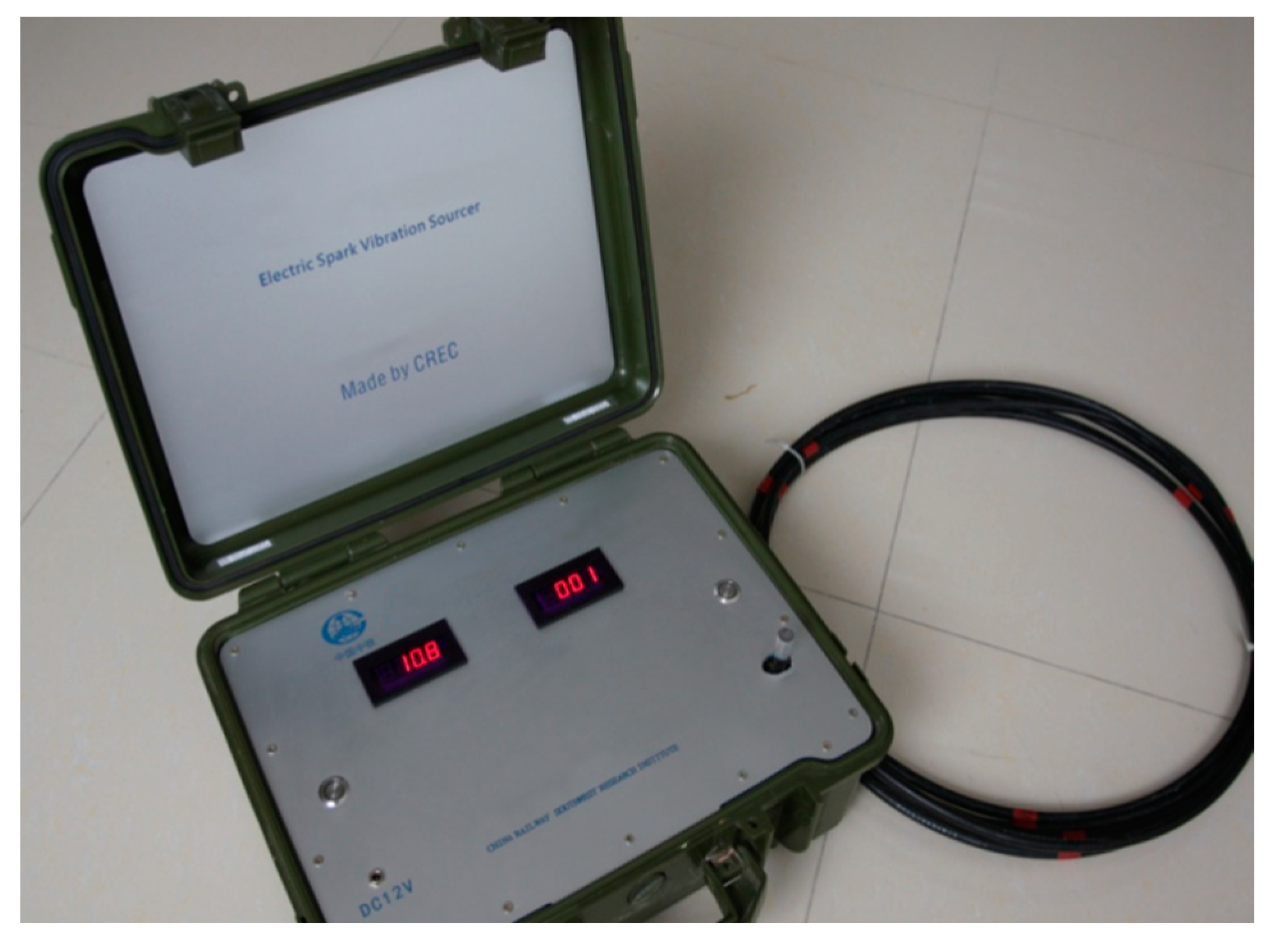

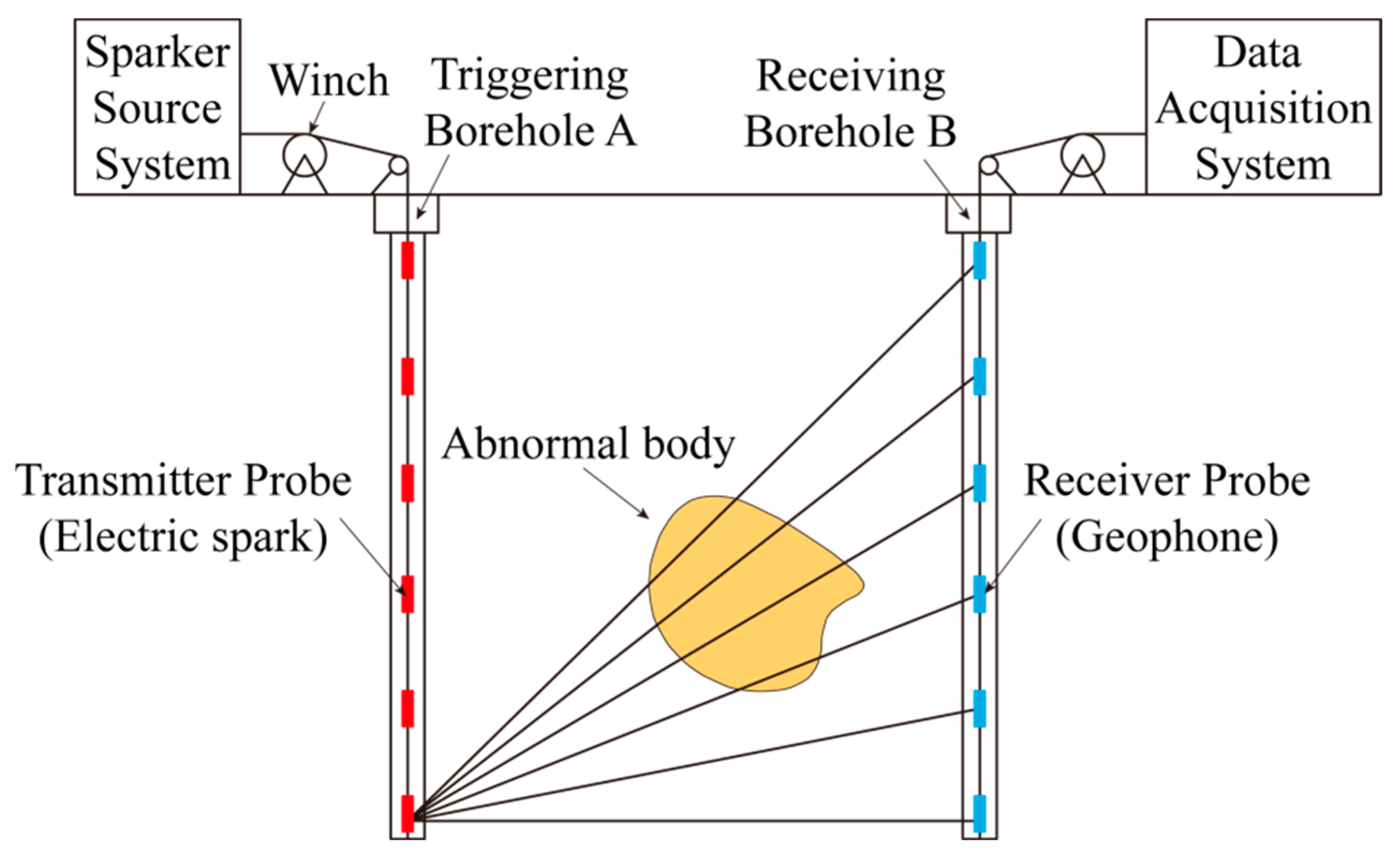
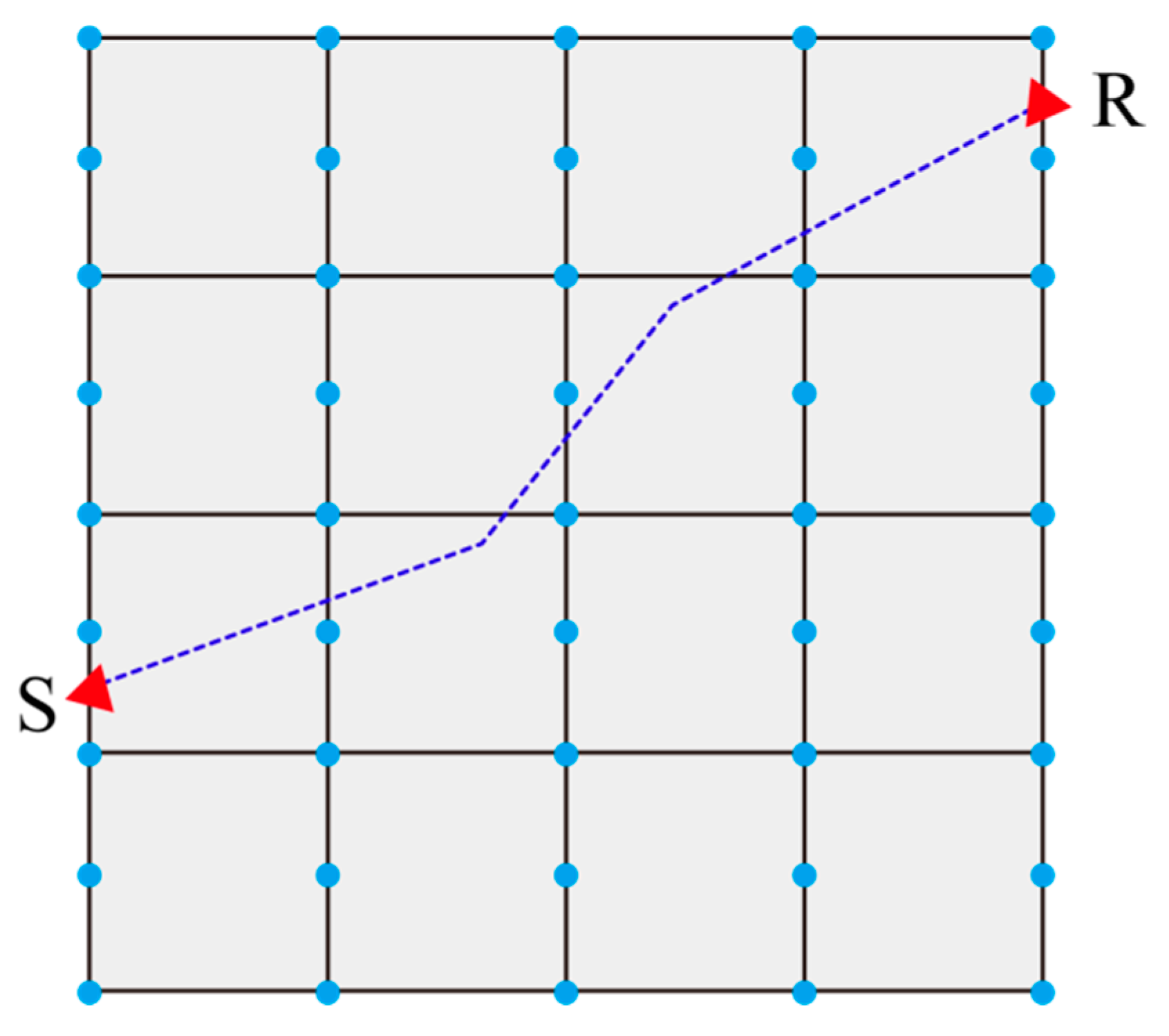

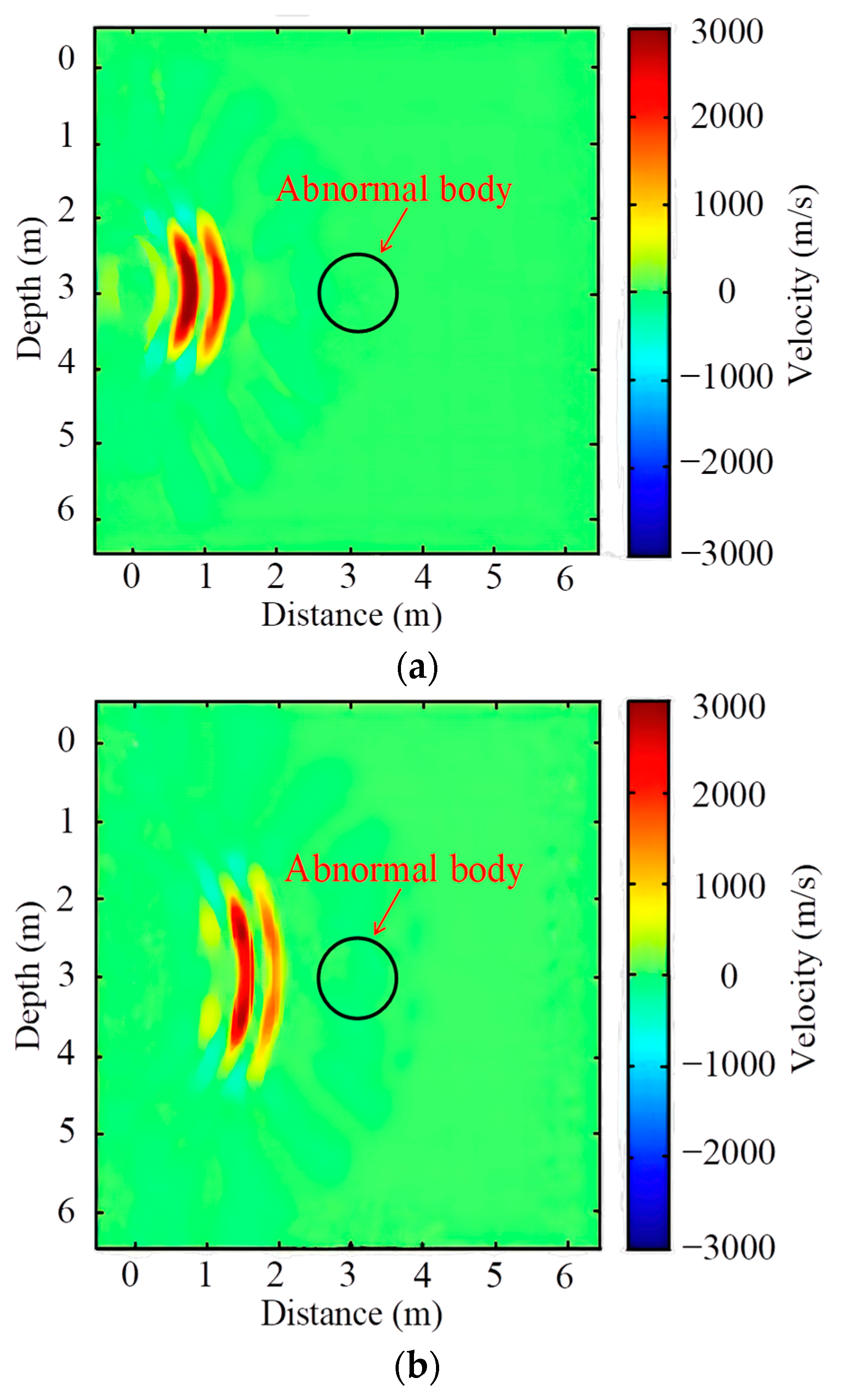
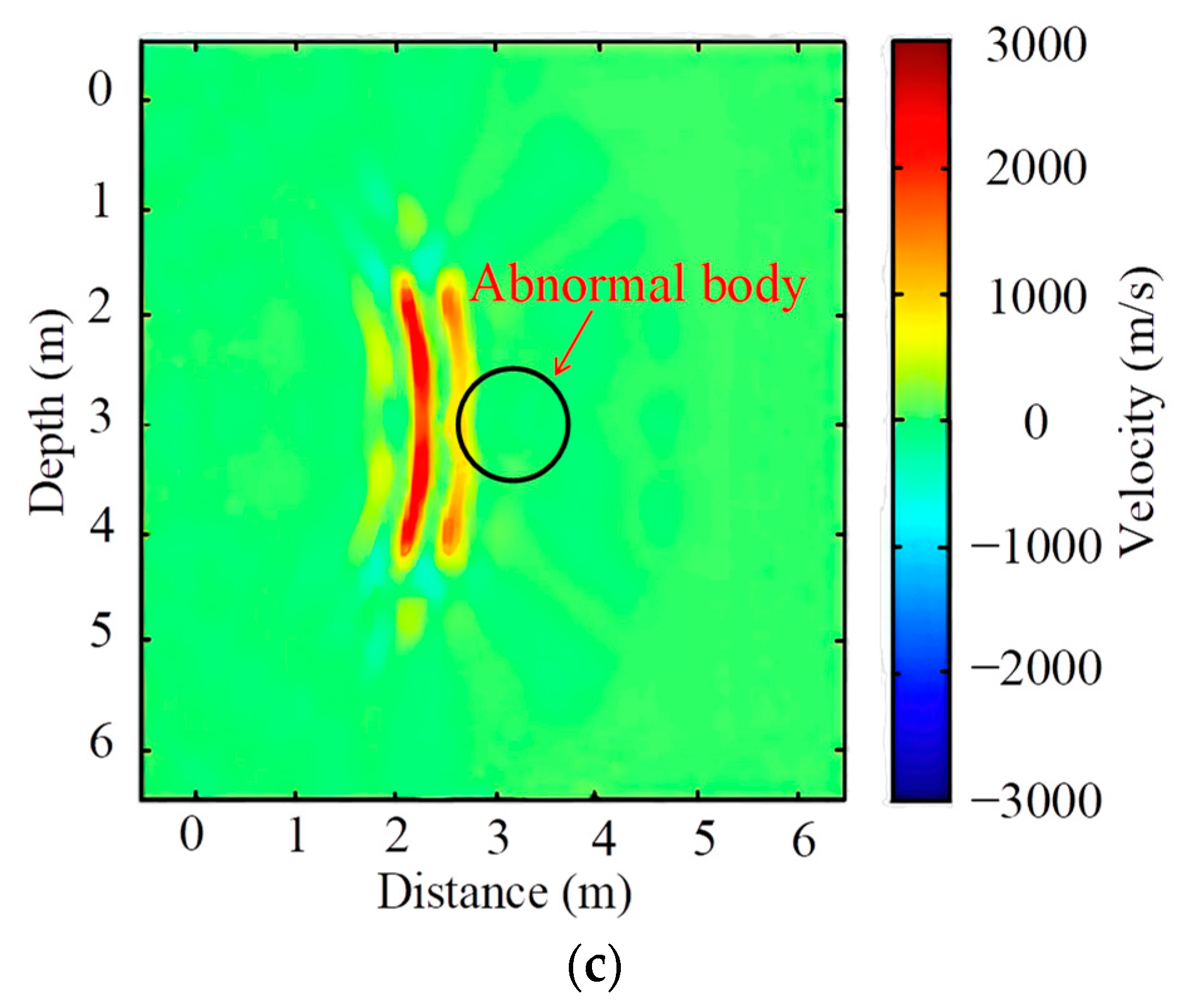


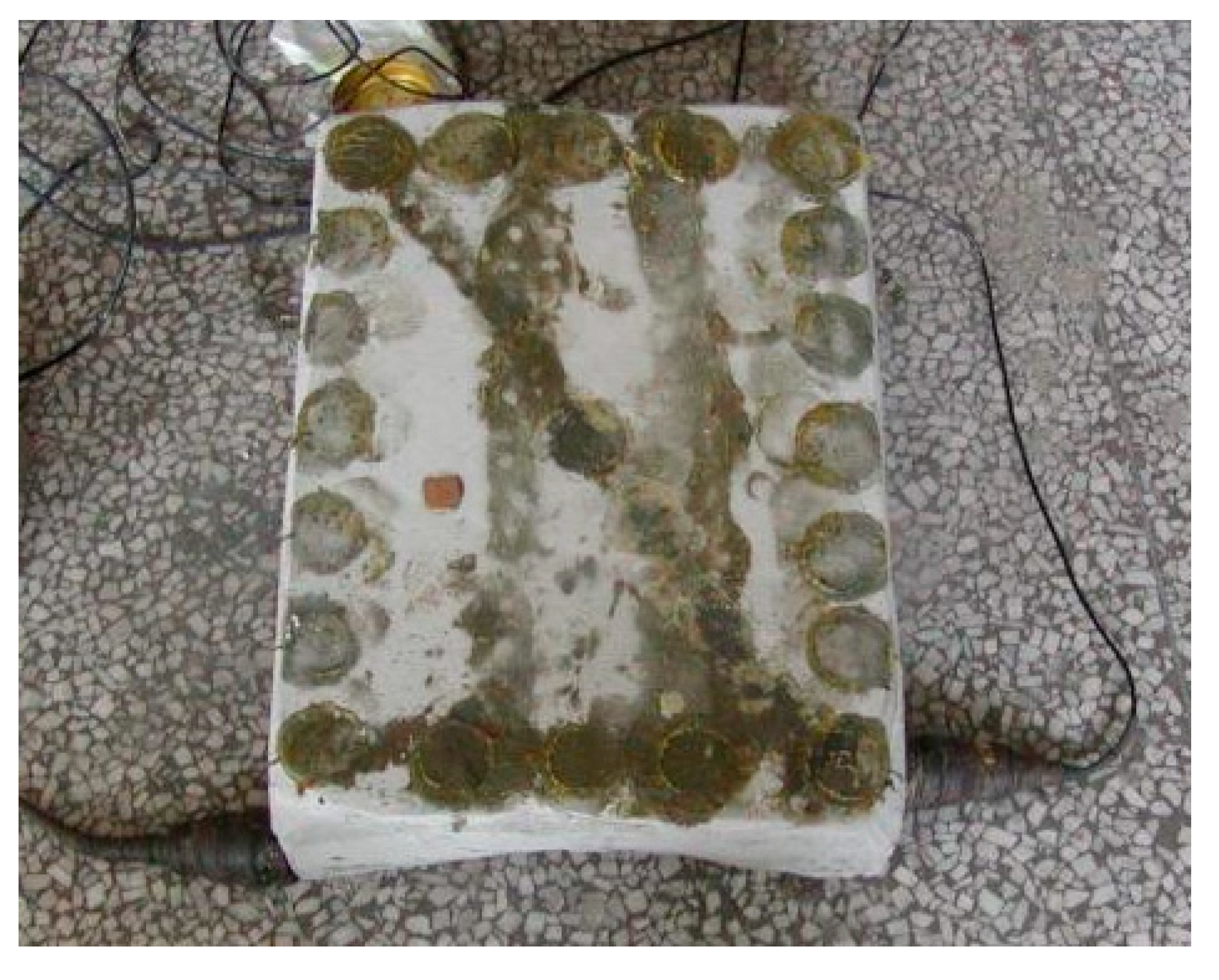
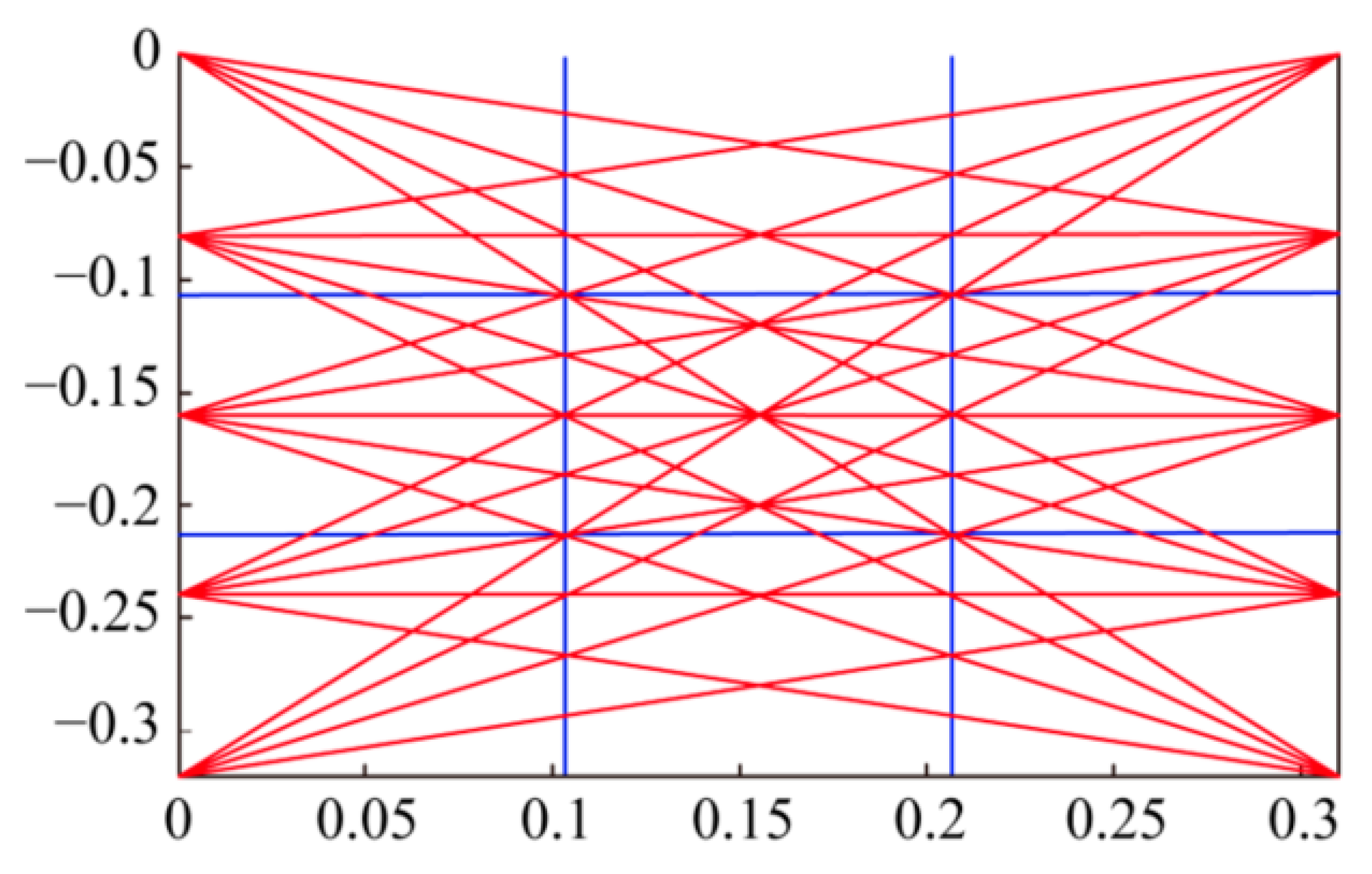
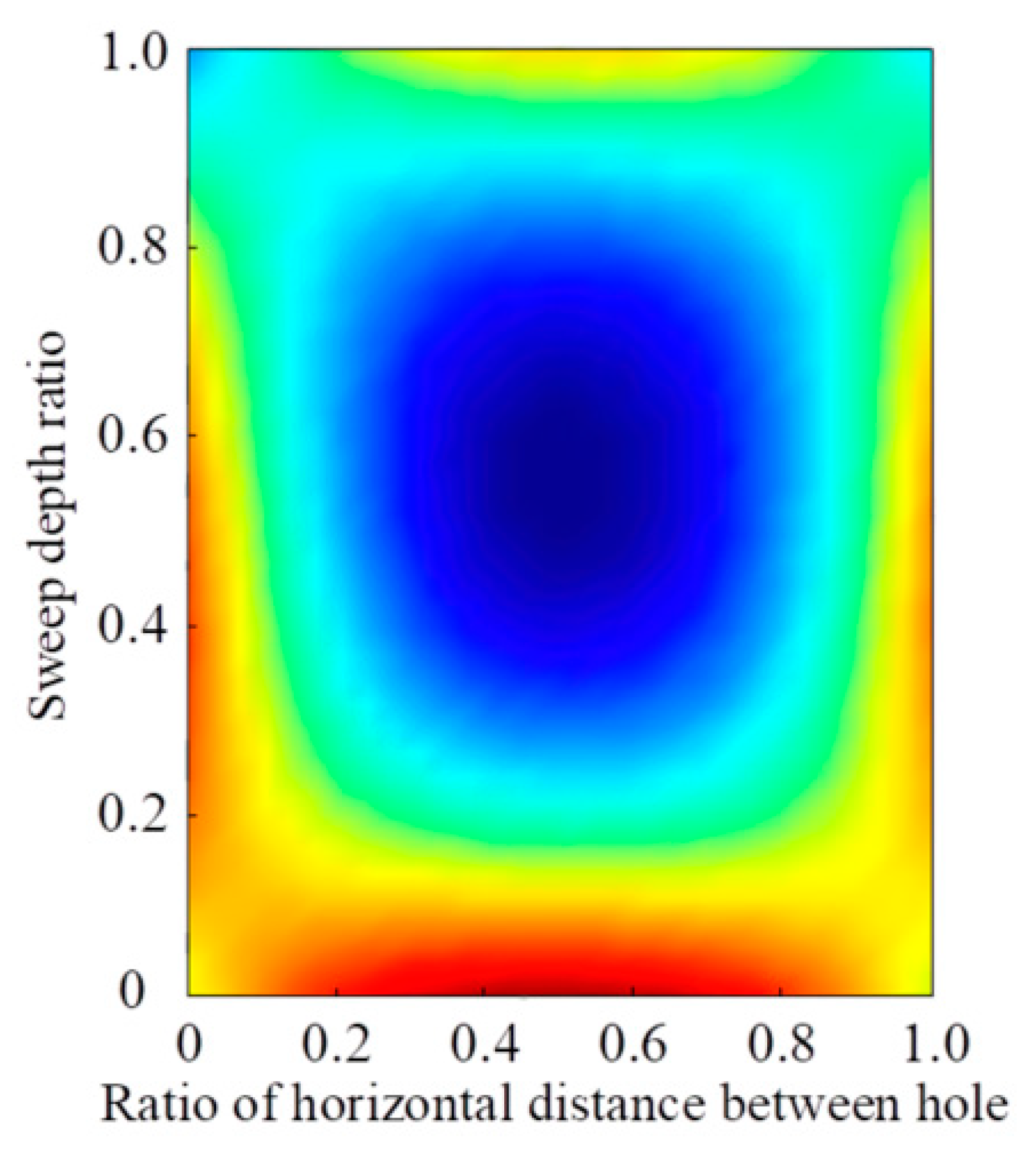
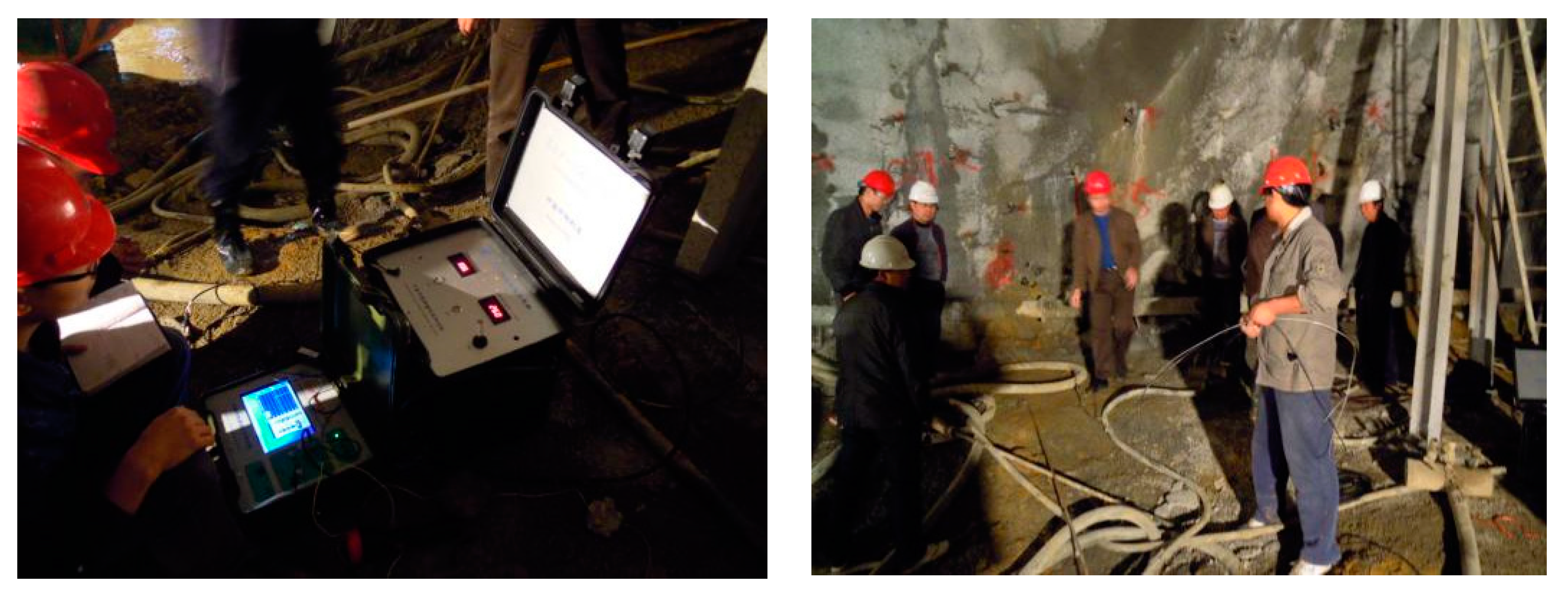
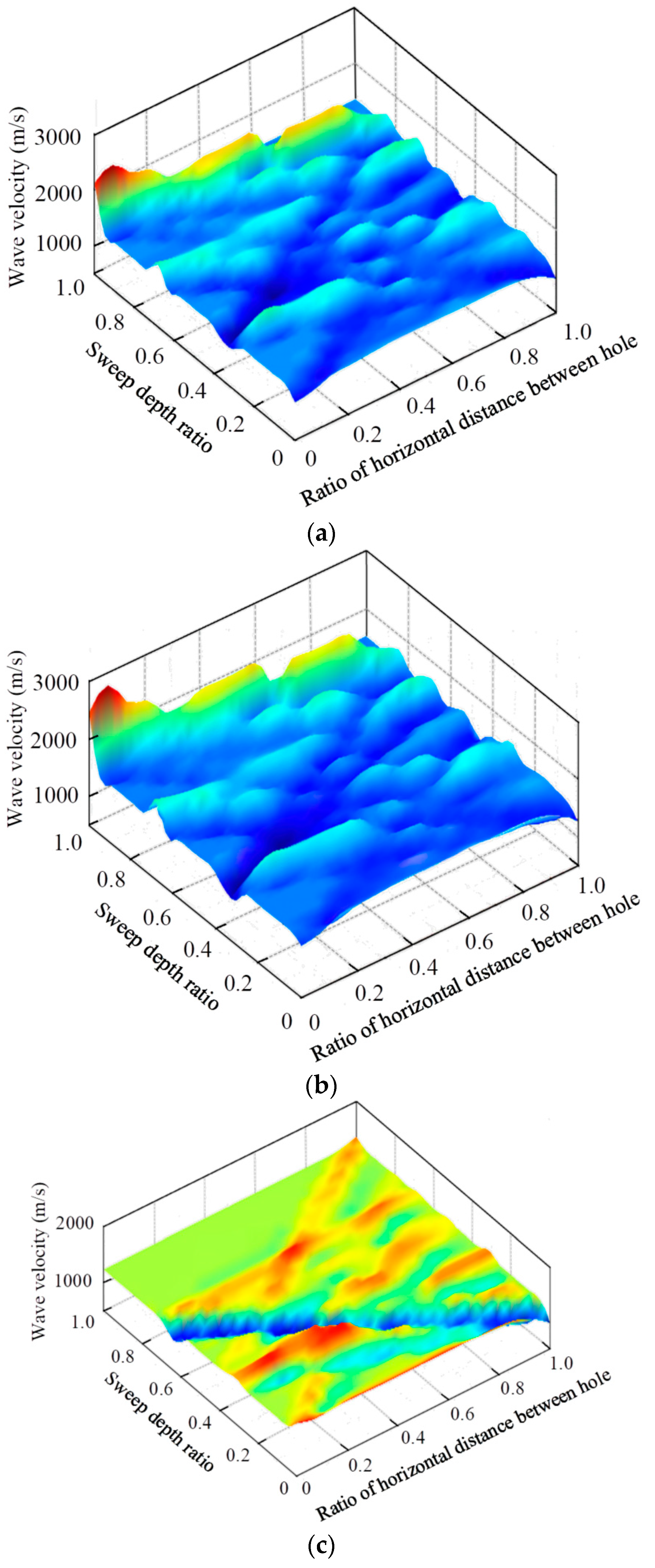
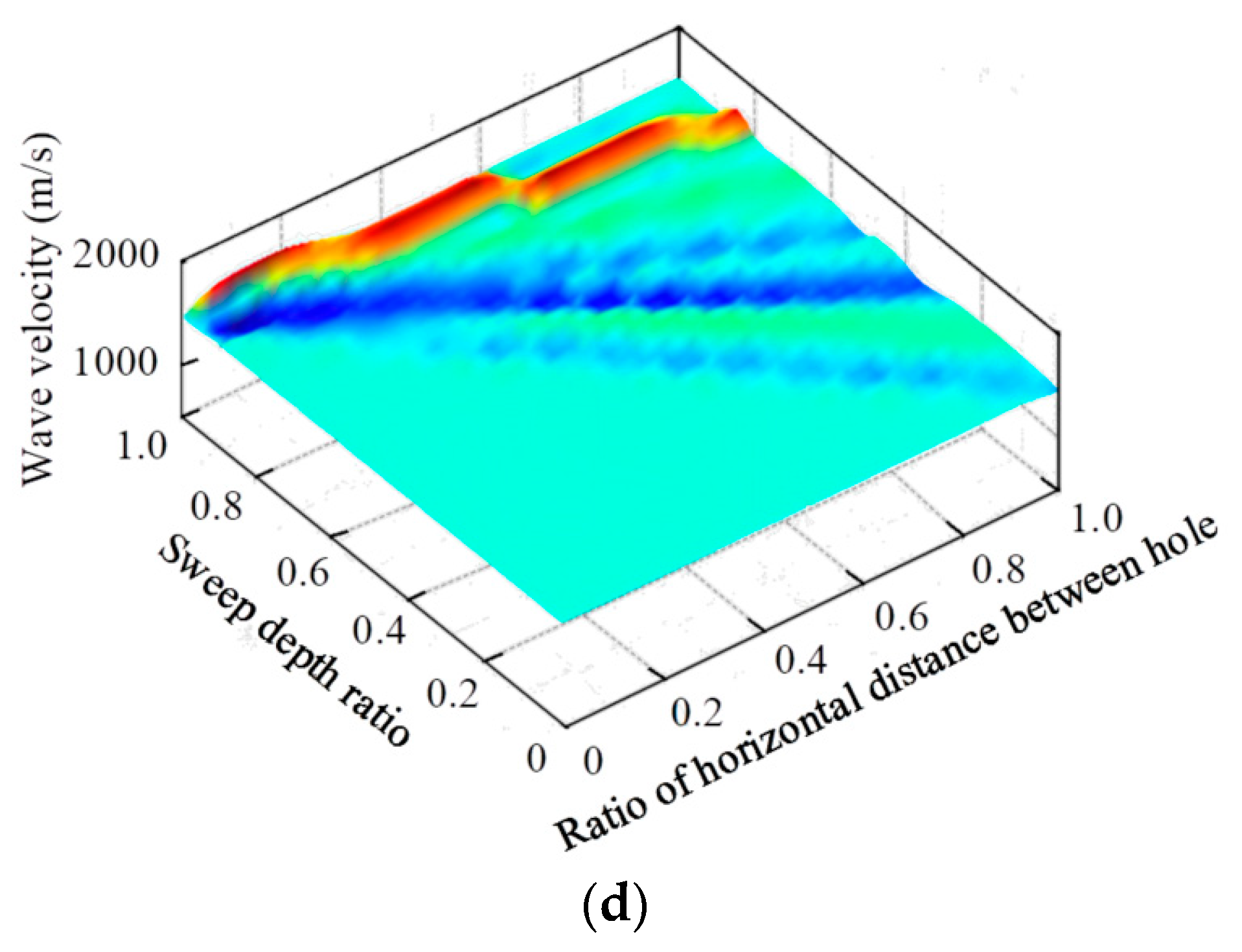
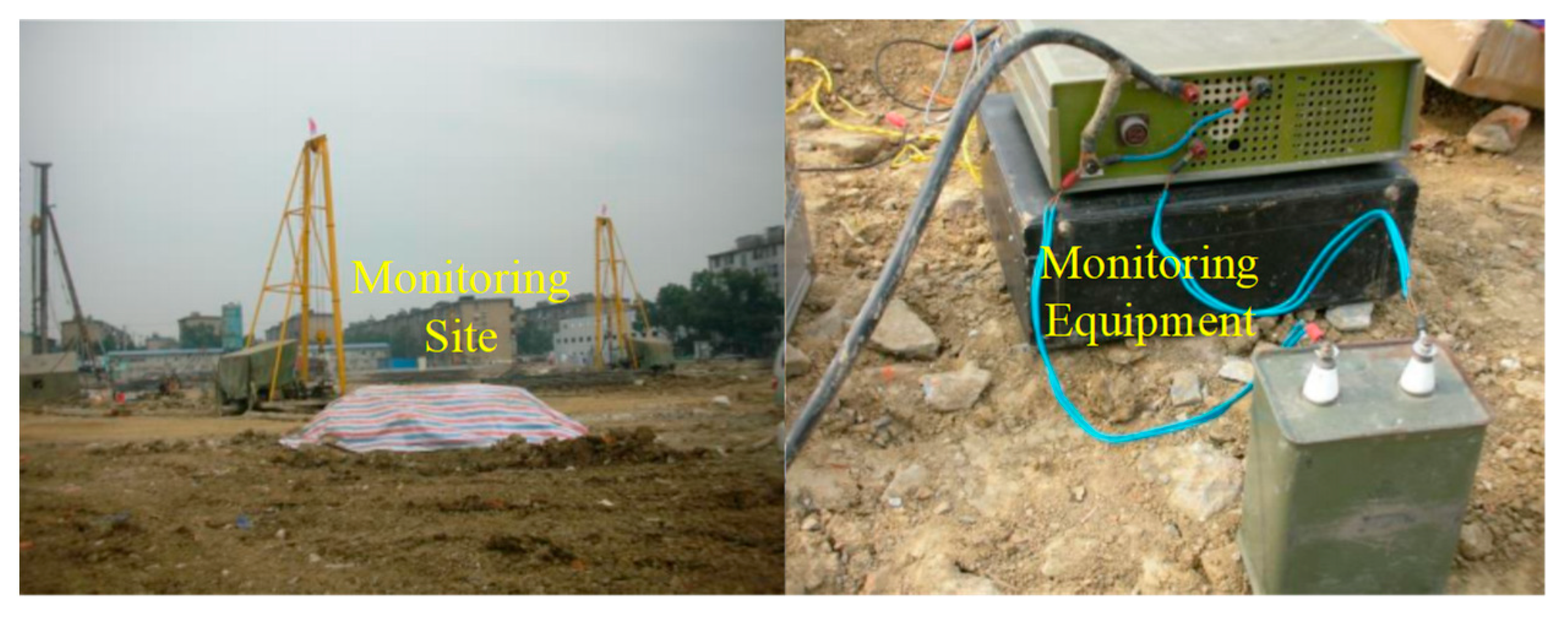
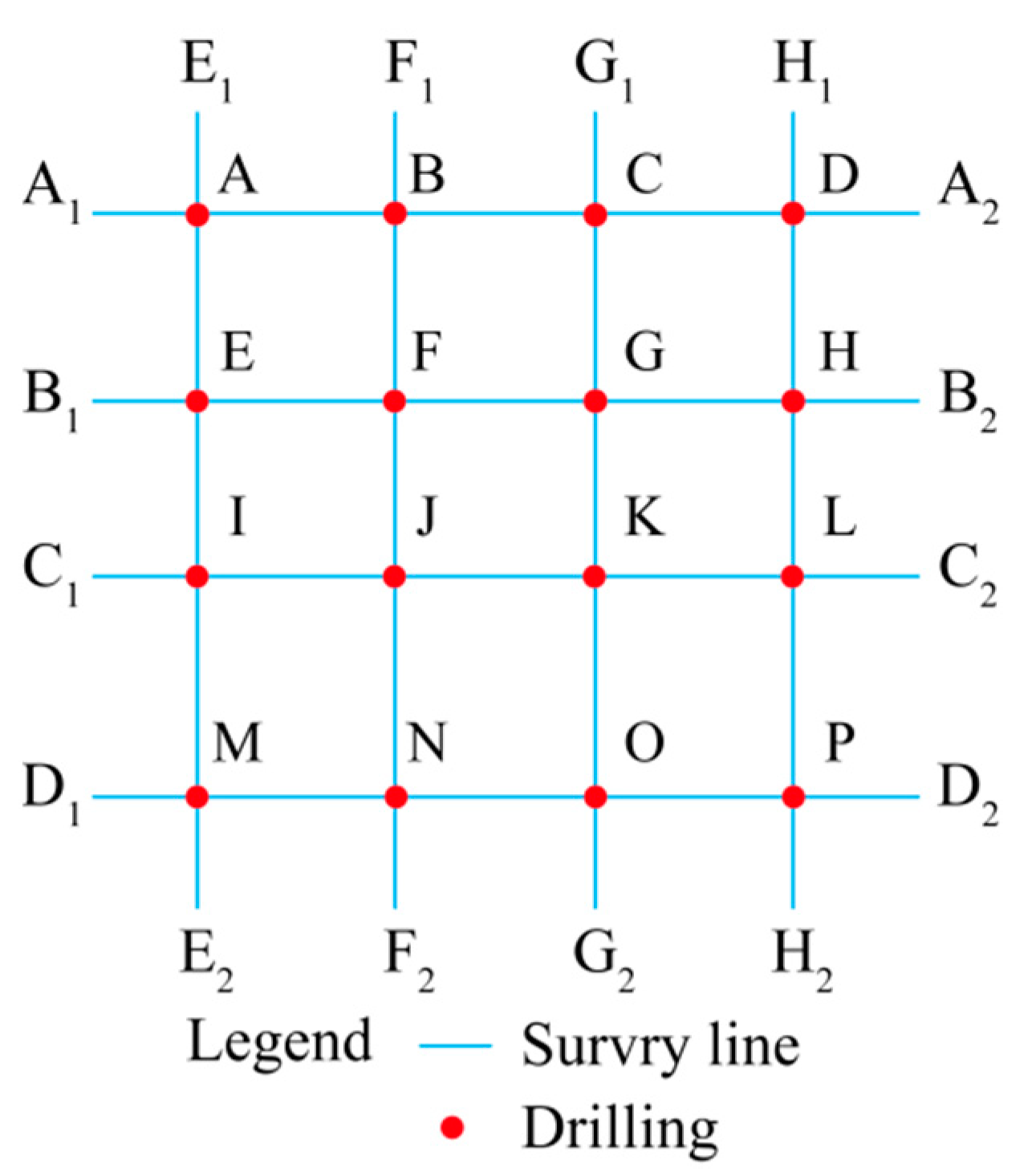
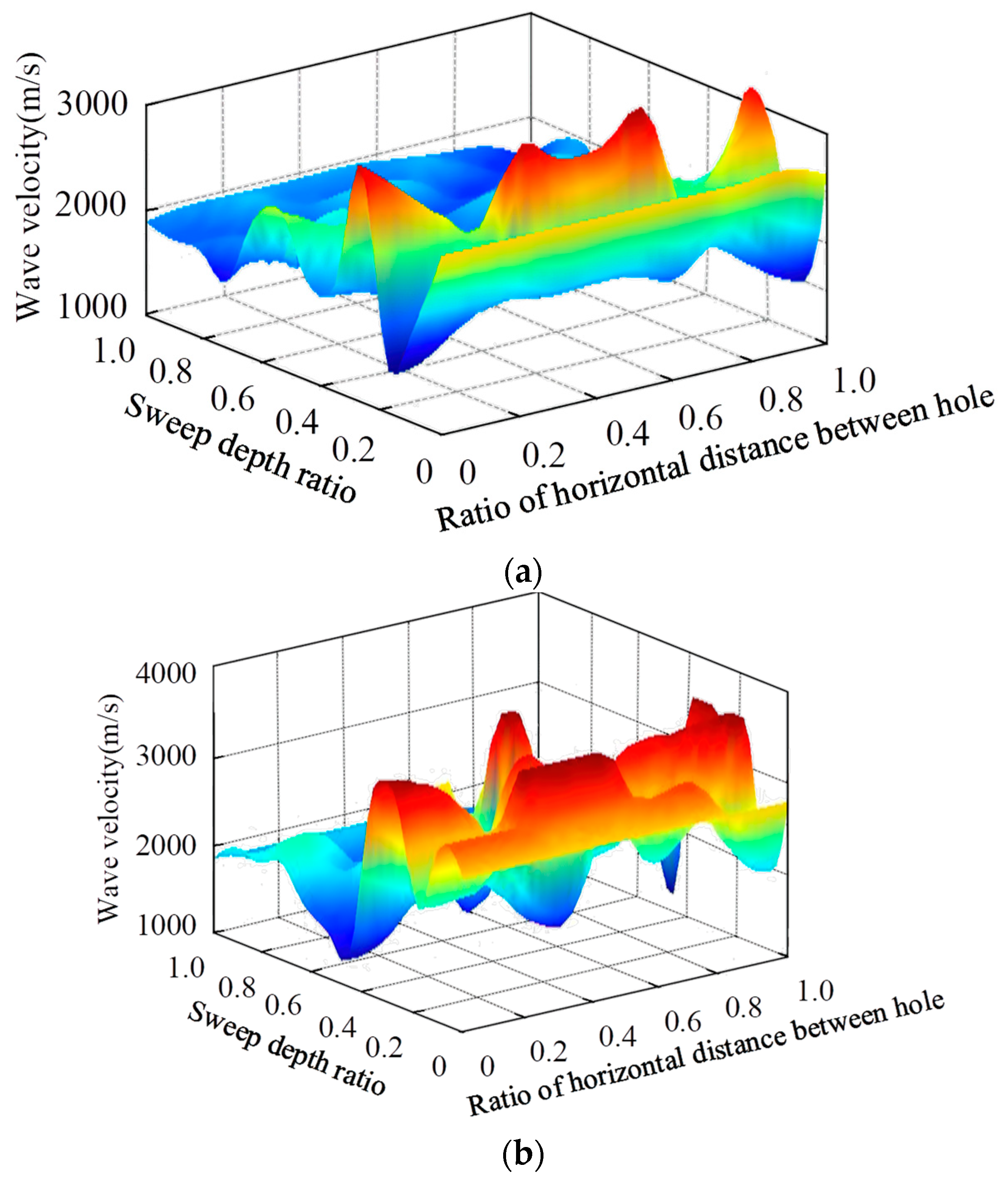

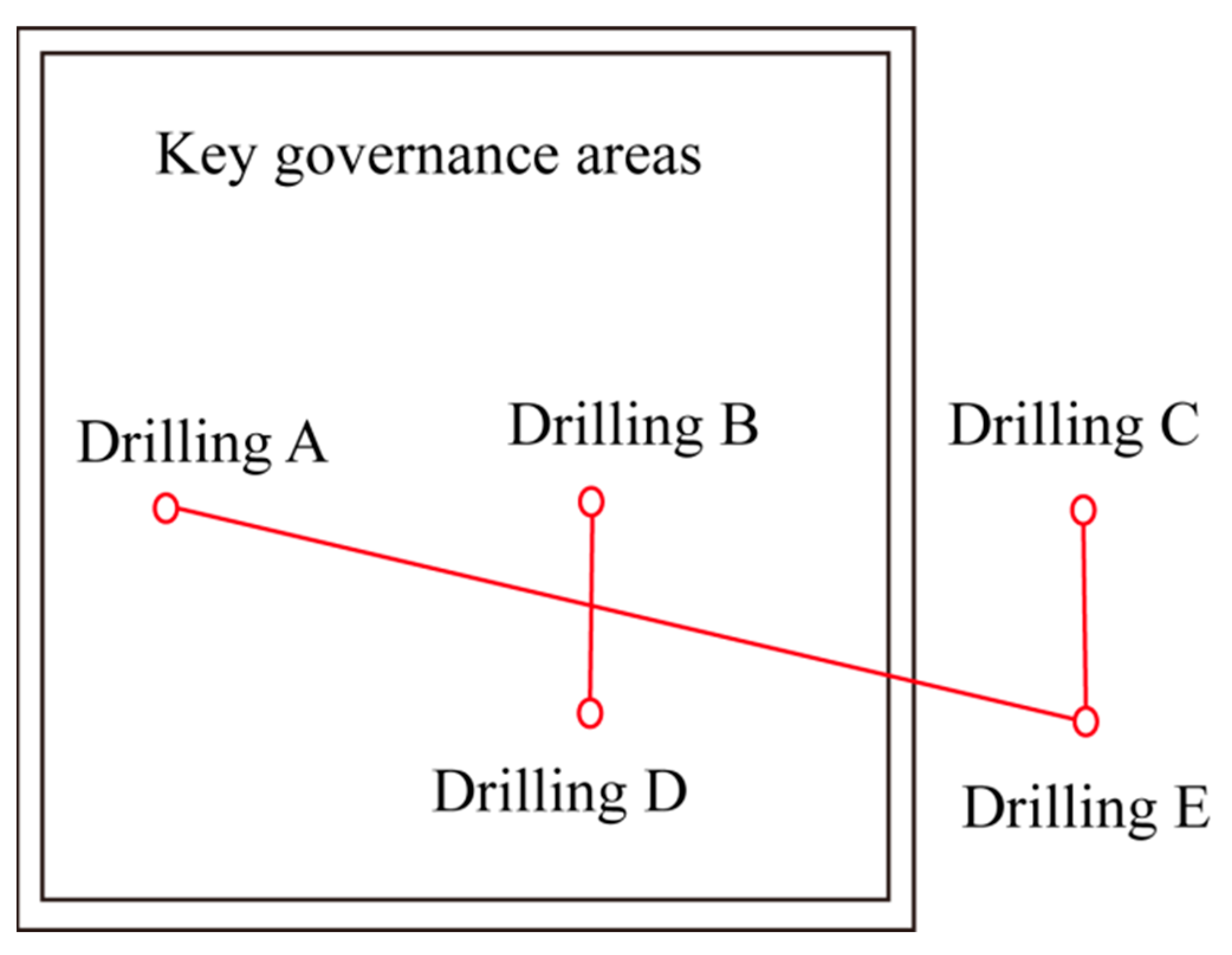
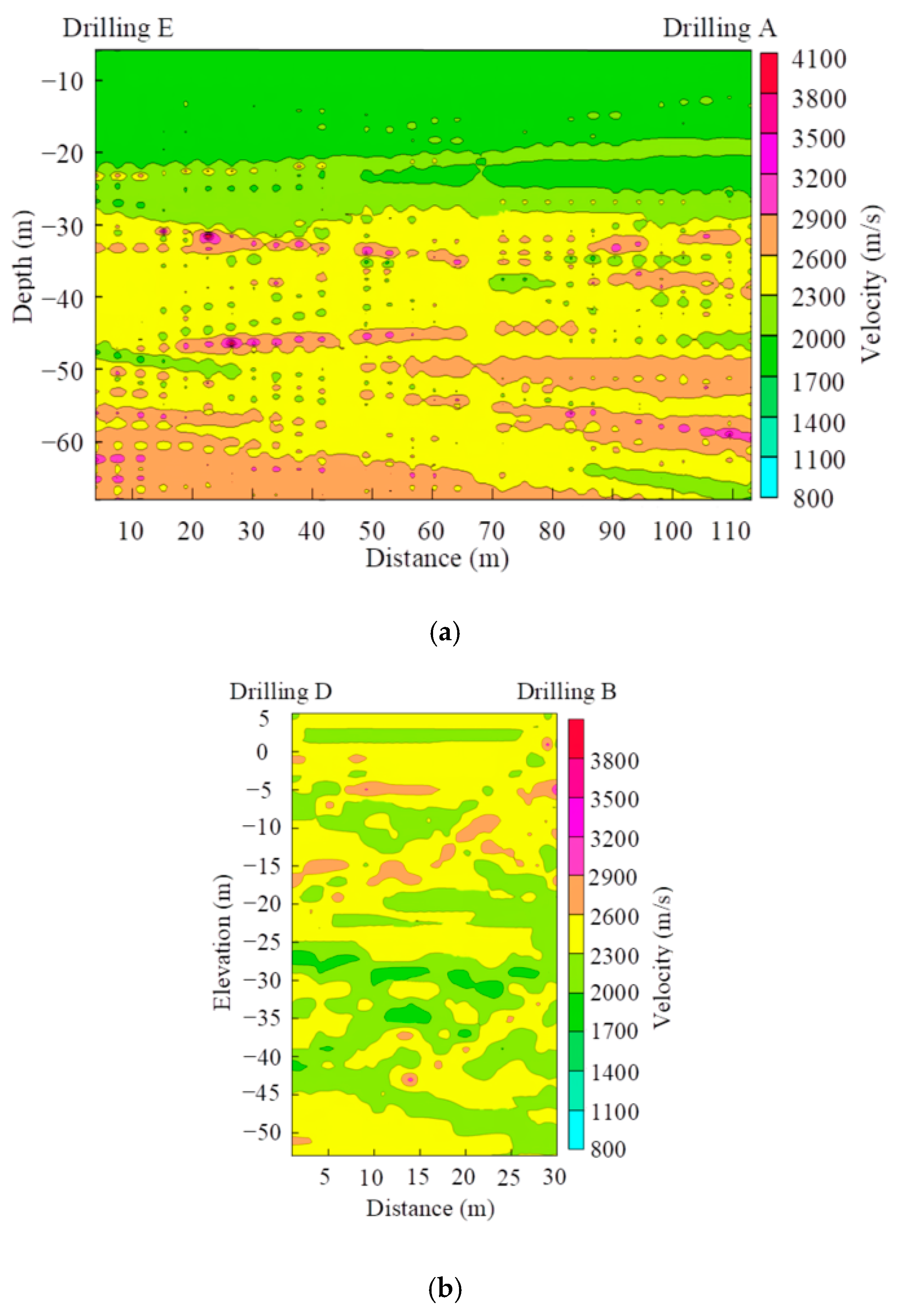
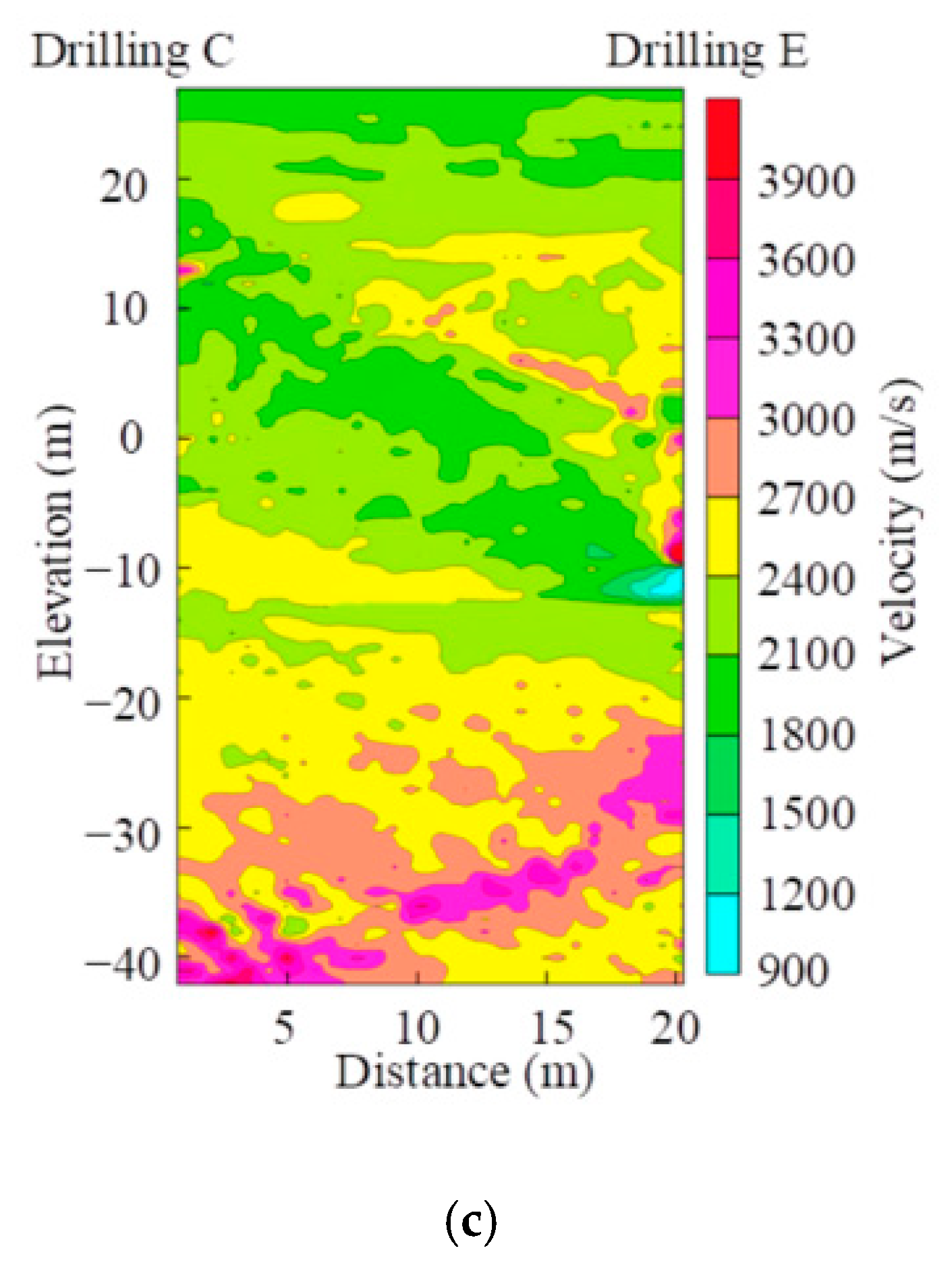
| Name | Wave Velocities (m/s) |
|---|---|
| Silty clay | 1200~2500 |
| Sandy clay | 300~900 |
| Sandstone | 2400~4200 |
| Conglomerate | 1600~4200 |
| Argillaceous limestone | 2000~4400 |
| Granite | 4500~6500 |
Publisher’s Note: MDPI stays neutral with regard to jurisdictional claims in published maps and institutional affiliations. |
© 2022 by the authors. Licensee MDPI, Basel, Switzerland. This article is an open access article distributed under the terms and conditions of the Creative Commons Attribution (CC BY) license (https://creativecommons.org/licenses/by/4.0/).
Share and Cite
Dong, L.; Chen, J.; Song, D.; Wang, C.; Liu, X.; Liu, M.; Wang, E. Application of Long-Range Cross-Hole Acoustic Wave Detection Technology in Geotechnical Engineering Detection: Case Studies of Tunnel-Surrounding Rock, Foundation and Subgrade. Sustainability 2022, 14, 16947. https://doi.org/10.3390/su142416947
Dong L, Chen J, Song D, Wang C, Liu X, Liu M, Wang E. Application of Long-Range Cross-Hole Acoustic Wave Detection Technology in Geotechnical Engineering Detection: Case Studies of Tunnel-Surrounding Rock, Foundation and Subgrade. Sustainability. 2022; 14(24):16947. https://doi.org/10.3390/su142416947
Chicago/Turabian StyleDong, Lihu, Jundong Chen, Danqing Song, Chengwen Wang, Xiaoli Liu, Mengxin Liu, and Enzhi Wang. 2022. "Application of Long-Range Cross-Hole Acoustic Wave Detection Technology in Geotechnical Engineering Detection: Case Studies of Tunnel-Surrounding Rock, Foundation and Subgrade" Sustainability 14, no. 24: 16947. https://doi.org/10.3390/su142416947
APA StyleDong, L., Chen, J., Song, D., Wang, C., Liu, X., Liu, M., & Wang, E. (2022). Application of Long-Range Cross-Hole Acoustic Wave Detection Technology in Geotechnical Engineering Detection: Case Studies of Tunnel-Surrounding Rock, Foundation and Subgrade. Sustainability, 14(24), 16947. https://doi.org/10.3390/su142416947










